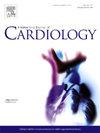危重心房颤动患者血清磷酸盐水平与死亡率之间的u型关系:来自MIMIC-IV数据库的见解
IF 3.2
2区 医学
Q2 CARDIAC & CARDIOVASCULAR SYSTEMS
引用次数: 0
摘要
心房颤动(AF)是危重症患者常见的心律失常,严重影响预后。虽然磷酸盐紊乱与心血管风险密切相关,但血清磷酸盐对危重心房颤动患者预后的影响仍不确定。方法利用MIMIC-IV数据库的数据,回顾性分析11744例危重心房颤动患者。主要终点为30天全因死亡率,次要终点为90天和1年。Cox回归模型量化了血清磷酸盐与死亡率之间的关系。使用受限三次样条(RCS)评估非线性关联,并通过分段Cox比例风险模型进一步表征拐点。结果30天、90天和1年死亡率分别为12.7%、14.4%和15.8%。Kaplan-Meier分析显示,高磷酸盐水平患者的死亡率更高。校正Cox回归显示,高磷血症独立预测30天死亡率增加(HR: 1.55, 95% CI: 1.36-1.78, p <;0.001), 90天(人力资源:1.55,95% CI: 1.37—-1.76,p & lt;0.001), 1年(人力资源:1.57,95% CI: 1.39—-1.77,p & lt;0.001)。RCS和两组Cox回归分析显示血清磷酸盐与死亡率呈u型非线性关系,低于阈值风险降低,高于阈值风险增加。在所有时间点都观察到类似的模式。结论:我们的研究结果表明,危重AF患者血清磷酸盐水平与死亡率之间呈u型关系,强调了维持最佳磷酸盐水平对治疗这一人群的重要性。本文章由计算机程序翻译,如有差异,请以英文原文为准。
U-shaped relationship between serum phosphate levels and mortality in critically ill patients with atrial fibrillation: Insights from the MIMIC-IV database
Introduction
Atrial fibrillation (AF), a common arrhythmia in critically ill patients, significantly affects prognosis. While phosphate disturbances are strongly associated with cardiovascular risks, the impact of serum phosphate on critically ill AF patients' prognosis remains uncertain.
Methods
Utilizing data from the MIMIC-IV database, we retrospectively analyzed 11,744 critically ill AF patients. The primary outcome was 30-day all-cause mortality, with secondary outcomes at 90 days and 1 year. Cox regression models quantified the association between serum phosphate and mortality. Nonlinear associations were evaluated using restricted cubic splines (RCS), with inflection points further characterized through segmented Cox proportional hazards model.
Results
Mortality rates at 30 days, 90 days, and 1 year were 12.7 %, 14.4 %, and 15.8 %, respectively. Kaplan-Meier analysis showed higher mortality in patients with high phosphate levels. Adjusted Cox regression demonstrated that hyperphosphatemia independently predicted increased mortality at 30 days (HR: 1.55, 95 % CI: 1.36–1.78, p < 0.001), 90 days (HR: 1.55, 95 % CI: 1.37–1.76, p < 0.001), and 1 year (HR: 1.57, 95 % CI: 1.39–1.77, p < 0.001). RCS and two-piece Cox regression revealed a U-shaped nonlinear relationship between serum phosphate and mortality, with risk decreasing below a threshold and increasing above it. Similar patterns were observed across all time points.
Conclusion
Our findings demonstrated a U-shaped relationship between serum phosphate levels and mortality in critically ill AF patients, highlighting the importance of maintaining optimal phosphate levels in managing this population.
求助全文
通过发布文献求助,成功后即可免费获取论文全文。
去求助
来源期刊

International journal of cardiology
医学-心血管系统
CiteScore
6.80
自引率
5.70%
发文量
758
审稿时长
44 days
期刊介绍:
The International Journal of Cardiology is devoted to cardiology in the broadest sense. Both basic research and clinical papers can be submitted. The journal serves the interest of both practicing clinicians and researchers.
In addition to original papers, we are launching a range of new manuscript types, including Consensus and Position Papers, Systematic Reviews, Meta-analyses, and Short communications. Case reports are no longer acceptable. Controversial techniques, issues on health policy and social medicine are discussed and serve as useful tools for encouraging debate.
 求助内容:
求助内容: 应助结果提醒方式:
应助结果提醒方式:


